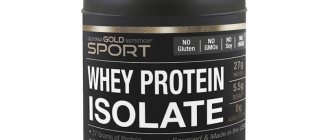© korchemkin — stock.adobe.com
Share:
What type of sports nutrition protein is most often used in bodybuilding, crossfit, powerlifting and other types of athletics? The correct answer is whey protein, which is considered one of the best types of protein on the planet. Why is it so effective in strength sports, is its value overestimated, and which whey protein is best for CrossFit? You will find detailed answers to these questions in our article.
General profile
How is whey protein different from any other protein? First of all, whey protein is of animal origin, which means it is not suitable for vegetarians. Whey protein is a complex protein that contains the essential amino acids for muscle growth (leucine, isoleucine, valine). The compounds have a high absorption rate and tolerability for the athlete.
What is whey protein made from? From the cheapest raw material - whey. Professional companies purchase milk used in the separator for further drying, after which they purify the resulting raw materials and sell it as a professional mixture.
Why whey and not milk? Because of lactose. Since whey is a product of secondary processing of milk with the release of casein from it, a side effect will be a decrease in lactose levels (as in kefir). This reduces the burden on the digestive system and the risk of diabetes. In addition, this reduces the calorie content of the final product by 20-25%.
Let's look at the general profile of whey protein.
| Squirrel profile | |
| Absorption rate | Extremely high |
| Price policy | One of the cheapest types of protein |
| The main task | Closing protein windows after exercise |
| Efficiency | When used correctly, high |
| Purity of raw materials | Quite tall |
| Consumption | About 3 kg per month |
The benefits of whey protein. Scientific research
The beneficial properties of whey protein are explained by its special amino acid composition, rapid absorption rate, content of biologically active substances, and, of course, the fact that it is a source of protein.
Among these useful properties:
- benefits for gaining muscle mass;
- benefits for weight loss;
- Benefit for health.
1 Benefits for gaining muscle mass
Scientific research suggests that whey protein is beneficial for building muscle mass , maintaining it, repairing it, and increasing muscle strength 1-6. Of course - subject to physical activity.
Proteins are the main building blocks in our body.
During the digestion process, the protein molecule is destroyed to the level of amino acids, from which muscle proteins are then “assembled” - muscle mass grows.
All proteins consist of amino acids, which are connected to each other like links in a chain. The body can create some of them itself (nonessential amino acids), others must be constantly supplied with food (essential amino acids).
Amino acids make up organs, tissues, tendons, enzymes, neurotransmitters, hormones and muscles.
The best protein can be called a protein that contains all the essential amino acids in the quantities needed by a person and is absorbed as completely as possible.
Whey protein is one of the best.
And that's why.
Properties of whey protein that explain its effectiveness for gaining weight:
Construction material
It contains all the essential amino acids, the building blocks needed for the synthesis of muscle proteins and anabolic hormones that stimulate even more muscle growth.
Hormones
Whey protein, when ingested by the body, increases the production of anabolic hormones that stimulate muscle growth, in particular insulin 17.
Amino acids BCAA and Leucine
is particularly high in (leucine, isoleucine and valine), which are known for their anabolic function 14. Whey protein is 25% BCAA; this is more than any other natural protein.
If you think what we do is important, support our project!
YES!
The amino acid leucine is often called “the most anabolic amino acid ,” highlighting its important role in muscle growth. It stimulates muscle protein synthesis at the molecular and genetic level 18,19.
We recommend : BCAA amino acids: why are they needed in bodybuilding?
We recommend : Which is better protein or amino acids (+ bcaa)? Reviews from doctors and experts
Fast absorption
Whey protein is absorbed very quickly compared to other types of proteins 20.
Fast proteins are most often recommended to be taken immediately BEFORE, AFTER or DURING training , when it is important to ensure rapid emptying of the stomach and/or supply of amino acids to the muscles.
If you take it when the body does not have an urgent need for protein, then a quick injection of amino acids will produce the effect of carbohydrates: they will be used to provide energy or converted into fat .
This is why taking whey protein at night is a mistake .
The effectiveness of whey protein in stimulating muscle growth is also indirectly evidenced by the fact that the protein in a mother's breast milk consists of 60% whey protein, and 20% cow's protein.
Comparison of the effectiveness of whey protein with soy and casein in gaining muscle mass
Comparative tests of whey protein with other types of proteins show whey to be more effective than soy protein and casein: whey is 31% more effective at gaining muscle mass than soy protein, and 132% more effective than casein when taken after a workout 6.
(The experiment used whey protein hydrolysate).
The study authors attributed this difference to the faster absorption rate of whey protein and its higher content of the amino acid leucine.
Other studies show similar results 26,27.
A few words about casein.
There is a significant difference in the speed of absorption between casein and whey protein: casein is a “slow” protein that is absorbed over several hours, providing a long-term gradual release of amino acids into the blood. This makes it useful as a source of protein during periods when the body is without food for a long time.
Read us on the networks
That is why casein and products containing it, such as cottage cheese, are recommended to be taken at night.
The combination of whey protein and casein has ideal properties for muscle growth 28-32, as it has the advantages of both types of protein in the rate of absorption.
One of the principles of competent use of proteins for gaining muscle mass is the ability to use the properties of “fast” and “slow” proteins.
The benefits of whey protein for gaining muscle mass are explained by its complete amino acid profile, especially its high content of BCAA amino acids, rapid absorption and stimulation of the production of anabolic hormones
We recommend : Protein and alcohol: how does drinking beer affect muscle growth?
2 Benefits of whey protein for weight loss
The effectiveness of whey protein for weight loss has been shown in numerous studies in normal-weight, overweight, and obese people 7,9.
However, it is important to understand that the weight loss benefits apply to all protein products and are not exclusive to whey protein. That is why on all low-carb diets, which are the most effective for weight loss, the proportion of protein increases.
This is explained by the fact that:
- protein, in comparison with carbohydrates and fats, saturates better and suppresses appetite : on a protein diet, a person on average eats 440 Cal less per day 34-38;
- protein foods increase the rate of internal metabolism by 80-100 cal per day; this is important, since internal metabolism is the main consumer of calories in the body, which means its activation is one of the most important factors in losing weight.
- Digesting protein requires approximately 30% more energy than digesting carbohydrates and fats.
In one study, when subjects ate 25% of their total calories with protein, it resulted in greater satiety (60% more) and a 50% reduction in the desire to eat before bed 39 compared to a diet with a normal amount of protein. protein.
A similar effect is observed when consuming other protein foods, such as eggs.
According to a meta-analysis of available studies in which a total of more than 600 people tried to lose weight, increasing the proportion of whey protein along with strength training can help you lose an average of 4 kg while maintaining and even building muscle mass 40.
In one experiment, whey protein was superior to egg whites, tuna, and turkey in reducing appetite and the number of calories consumed in the next 10 meals.
Soy protein is significantly less effective for weight loss than whey protein 8.26.
In addition, numerous facts indicate a risk of harm to the health of soy and products made from it, which is especially relevant when consumed regularly.
Whey protein can be beneficial for weight loss as it has appetite suppressant properties and increases the rate of internal metabolism. But this is not an exclusive property of whey protein: all protein products have this effect.
We recommend : Casein or Cottage Cheese? When is the best time to eat cottage cheese for weight loss and muscle gain? Is it possible for the night?
3 Health Benefits of Whey Protein
Cow's milk, from which whey protein is derived, is known for its nutritional properties: it is a source of protein, vitamins and minerals, the most famous of which is calcium.
But the nutritional benefits of milk are not limited to.
It also contains biologically active substances that provide protection against diseases in the body of young mammals and enhance its ability to fight them - immune function.
It is believed that consumption of these bioactive substances by adults can strengthen the immune system and provide numerous health benefits 47,48.
Those. The health benefits of whey protein, which are listed below, are not inherent in whey protein itself in the sense of a “type of sports nutrition”, but in the biologically active substances of milk it contains (including some amino acids and specific proteins).
It is obvious that the concentration of such substances in different types of whey protein is different and naturally decreases during technological processing, in proportion to the degree of this processing.
The health benefits of whey protein include:
- decreased blood pressure 49.50;
- normalization of blood sugar levels 51;
- antidepressant and anti-stress effects 52;
- reduction in the level of “bad” low-density cholesterol and triglycerides in the blood 50;
- anticancer effect 53,54,55,56;
- improvement of liver function in hepatitis 57,58;
- increased bone strength 59;
- strengthening immune function in HIV carriers 60,61.
Scientific studies indicate the benefits of biologically active substances of whey protein for human health (for cardiovascular health, anti-cancer effects, bone strength, immunity). However, their concentration varies greatly among different types of whey proteins.
We recommend : The benefits and harms of milk: expert reviews
Varieties
Whey protein is the name of a product group. These types of whey protein are the most common on the market:
- Classic protein. The ratio of pure protein is about 70%. Cheapest source. It is not a commercial success due to weak advertising.
- Whey prot. The ratio of pure protein is about 85%. It is actively advertised by manufacturers as the coolest, most sophisticated and effective - because of this, it is more expensive than KSB and classic. Sold only in small packaging. Effective, but expensive.
- KSB prot. The ratio of pure protein is about 80%. Cheapest source. Commercially unsuccessful due to weak advertising.
- Isolate. The ratio of pure protein is about 90%. Unjustified consumption of protein. Needed only for bodybuilders-chemists who clearly calculate the fermentation and intake of a pure product, monitoring the calorie intake down to 1% of consumption.
- In complexes. The ratio of pure protein is about 50%. Used in gainers and complex proteins. Efficiency is low.
What is whey protein
When milk is curdled (turned into cottage cheese), a liquid medium saturated with nutrients - whey - is formed. Its high biological value is due to the presence of protein, vitamins, hormones, organic acids, and microelements.
Table 1. Average composition of whey.
A concentrated product from a mixture of globular proteins (performing dynamic functions) is whey protein - the most popular type of nutrition among athletes. Compared to whole proteins, it has the highest rate of breakdown and digestibility. Therefore, it is classified as a so-called “fast” protein.
The amount of peptides and amino acids in the bloodstream increases sharply after their consumption in the first 30-40 minutes. This is a great advantage, because the athlete’s body, which is in a state of catabolism, needs emergency protein replenishment.
If, after intense physical activity, you look at muscle fibers under a microscope, they will appear “tattered” and even torn due to the destructive effects of free radicals. Another portion of structural muscle protein is consumed during exercise. If protein reserves are not renewed in a timely manner, then the muscle not only will not grow, but will not even return to its original volume! It is necessary to immediately “feed” whey protein, then it will quickly recover to its original state and will continue to grow (it is worth remembering that muscle mass grows only during the rest period).
+ 109.88 bonus rubles
Optimum Nutrition100% Whey Gold Standard 2270 gWhey protein5,494 rub.
+ 29.7 bonus rubles
BombBarWhey Protein 900 gWhey proteinRUR 1,485
+ 100.54 bonus rubles
Ultimate NutritionProstar Whey Protein 2270 gWhey proteinRUR 5,027
+ 194.64 bonus rubles
Optimum Nutrition100% Whey Gold Standard 4545 gWhey protein9,732 rub.
What is it needed for
To understand why athletes of different strength types need whey protein, you will have to delve into biochemistry. The rate of absorption of this protein varies from 3 to 10 minutes. Hence, it is taken before, during and after exercise. What does this give?
- Before training – reducing the catabolic effect of pumping training.
- During training – a temporary improvement in strength indicators by 2-3%, which allows you to lift a few more weights.
- After training – closing the protein window.
As a result, this stimulates the development of the athlete, moving his athletic performance forward.
Proper intake of whey protein will help:
- During drying - in the early stages (before sodium is drained) it will reduce catabolism in the muscles immediately after training, without affecting the overall balance of calorie intake. At this time, the synthesis of new amino acids is a priority for the muscles - which means that the body will not burn protein into carbohydrates.
- For mass gain, increase protein levels without affecting calorie content. This allows you to get a higher ratio of pure muscle mass to total weight.
- When losing weight, it will increase your overall well-being by adding protein. Will reduce the load on the gastrointestinal tract. Will be a replacement for frequent snacks to speed up metabolism
- While maintaining shape. Makes it easier to control your protein intake. It will increase strength indicators, which will create an excellent anabolic background.
What types of whey protein are there?
Based on technology and methods of obtaining protein from whey, protein is divided into the following groups:
- Whey protein concentrate.
To obtain it, the whey is filtered through ceramic membranes. The hole diameters of such filters are different (technically it is difficult to make them the same), and the filtration is not very clean. The mass remaining on the surface of the membrane contains from 40 to 75% protein, some fat and lactose. The latter causes indigestion and bloating in a certain part of people. And yet, the concentrate is a good product among protein mixtures. In addition, it is absolutely affordable.
- Whey Protein Isolate
To obtain it, long-term multi-stage or ion filtration is used. This is the latest method, which is characterized by high accuracy and degree of purification. The exchange is carried out in special reservoirs using natural or synthetic electrolytes (ion exchange resins). Fats, carbohydrates, and minerals are removed from whey, leaving high-quality and healthy pure protein (contains up to 97% protein). The isolate completely compensates for the lack of protein before and after sports activities. You need to carefully look at the composition, since sometimes they pass off as “Isolate” a mixture of it with concentrate.
- Whey Protein Hydrolyzate
Pure protein is produced by hydrolysis: a process that partially breaks down the protein using acid or enzymes. The resulting product is completely ready for absorption and is able to quickly penetrate muscle tissue. Its absorption goes very quickly. The cost is high.
This supplement is consumed regardless of the time of day, but most athletes prefer to take it before and after training. This type of protein is rich in leucine, so its dosages are small. To increase muscle mass, it is enough for a 90-kilogram athlete to take 25-35 grams immediately after intense exercise or instead of the usual protein supplement.
Table. Comparative characteristics of whey proteins.
| Type of whey protein | Advantages | Flaws |
| Concentrate | absorbed within 2 hours; pleasant to the taste; low price. | low protein content (40 – 60%); high lactose and lipid content (up to 60%) |
| Isolate | in 30 min. completely absorbed by the body; contains a lot of protein (95% - 97%); practically does not contain lactose and lipids (up to 5%); affordable; the taste is pleasant. | |
| Hydrolyzate | pure protein (up to 100%); traces of lipids and lactose (up to 0.5%) | not the most pleasant taste; expensive. |
Whey protein can cause allergies due to lactose and casein intolerance in some people.
How to use
How to properly take whey protein for strength athletes? In the specialized literature you can find a lot of articles about how it is taken for weight loss or weight gain. However, this is all a myth. Whey protein is not suitable for cutting or regular weight loss due to its amino acid profile and absorption rate. They cannot close the nighttime protein window, but they are quite suitable for daytime anti-catabolism.
Let's look at a typical whey protein intake regimen. For this we need:
- calculate net weight;
- count the number of workouts per week;
- Calculate your protein intake from natural foods.
Note. There is a myth that whey protein should not be taken in portions of more than 30 g of substrate at a time. In reality this is not the case - it all depends on individual tolerance. For some, this dose may be 100 g, while for others, 30 g will have to be divided into several doses.
Whey protein, like any other protein, is designed to overcome its deficiency in the body. Let's consider a classic situation. Athlete 75 kg, fat – 20%. He is actively gaining weight. Requires 2 g of protein per kilogram of body. The total protein intake from natural food is about 50 g of the complete amino acid complex. The general disadvantage is 70 g.
How to drink whey protein correctly in this case?
- On a training day. The first dose instead of lunch is 30 g of the mixture mixed with milk or yogurt. The second dose is taken within 15 minutes after the end of training to close the protein window - up to 60 g at a time. The third dose is optional, an hour after the last meal, but not earlier than 2 hours before bedtime.
- On a non-training day. Dose No. 1 instead of lunch – 30 g of the mixture mixed with milk or yogurt. The second dose is taken an hour after the last meal, but not earlier than 2 hours before bedtime.
That's all the secrets. No extreme regimens are needed to achieve optimal results. In addition, excessive indulgence in protein can negatively affect the digestive system. In particular, the athlete will simply stop absorbing natural protein.
Other protein sources (non-whey)
Soy protein
Soy protein is protein obtained from soybean plants/soybeans. Soy protein contains a large number of different amino acids and is absorbed very quickly. In addition, it significantly increases muscle protein synthesis.
Unfortunately, soy is not as rich in protein as whey. For example, when taking 30 grams of soy protein or whey protein, protein synthesis continues for about 2 hours after training in the first and second cases, but whey protein lasts even for 4 hours.
In another study, the thermic effect was 14.54% higher for whey protein than for soy protein, proving that soy protein may be more beneficial for weight loss. In this same study, the average peak oxygen consumption was 29.94% for whey protein and 23.98% for soy protein, suggesting that soy protein is more quickly digested and therefore not sufficient for sustained muscle protein synthesis.
Casein
Milk protein consists of whey and casein. Casein is considered the “other” protein. Just like whey protein, casein is a rich source of amino acids and supplies the body with all the necessary amino acids.
Casein digests more slowly than whey and as a result provides a longer period of amino acids entering the bloodstream. Therefore, it is especially useful to take it at night for the best muscle growth, and whey protein after training.
The advantage of casein over whey protein is that casein is more “filled” with amino acids than whey and takes longer to digest. The feeling of fullness lasts longer after taking casein, which can help if you want to lose weight by reducing your calorie intake.
Whey Protein and Other Protein Sources
The two most common criteria for determining the quality/efficiency of a protein source in general are the biological value and the degree of digestibility of the amino acids included in the protein. The biological value of a protein source is a practical parameter that evaluates the extent to which a living being is able to utilize that protein. It is calculated by analyzing nitrogen retention in the body after consuming a suspected protein source.
The degree of digestibility of the amino acids contained in a protein is a number between 0 and 1, which evaluates the quality of the protein based on the amino acid content in it relative to the human need for them. The higher the nutritional value of a protein and the degree of its digestibility, the more efficiently it is used by the body. Below is a table that summarizes the nutritional value and digestibility of the protein amino acids of the most common human protein sources:
| Protein sources | ||
| Protein | Pete . prices | Digestibility |
| Whey concentrates and isolates | 104-159 | 1.00 |
| Egg | 100 | 1.00 |
| Milk | 91 | 1.00 |
| Egg white | 88 | 1.00 |
| Cottage cheese | 84 | 1.00 |
| Tuna | 83 | ? |
| Fish | 82 | ? |
| Beef | 80 | 0.92 |
| Chicken | 79 | ? |
| Soybeans | 74 | 0.91 |
| Casein | 71 | 1.00 |
| Peanut | 68 | 0.52 |
| Yogurt | 68 | ? |
| Oat flour | 58 | 0.57 |
| Wheat | 54 | 0.42 |
Efficiency
How whey protein works when consumed correctly, and what you can achieve with it:
- Improvement of strength indicators. The main task of protein is precisely to strengthen muscle fibers in order to increase their initial strength capabilities.
- Increase in dry mass. If you follow your diet correctly and do not allow excessive increases in calorie intake, whey protein will improve the synthesis of internal protein, which will allow you to build up truly lean mass.
- Change in energy level. Whey protein, due to its absorption rate, will force the body to intensively synthesize ATP, which will also affect endurance performance.
- Feeling better.
- A little flooding with water. Although lactose-free, whey protein has a huge amount of sodium, which will cause slight flooding and make it unusable during the quality final drying stages.
Effect of Whey Protein on Muscle Mass and Strength
Whey protein is most often taken to build muscle and improve physical strength. This supplement is very popular among athletes, bodybuilders, fitness models, and those who regularly work out in the gym.
Here's how whey affects muscles and muscle strength:
- Whey powder provides the body with proteins and amino acids that are needed for muscle growth.
- Whey protein enhances the release of anabolic hormones that stimulate muscle growth (such as insulin).
- Whey protein is high in the amino acid leucine, which is known to stimulate muscle protein synthesis at the molecular and genetic level.
- Whey protein is digested and taken up by cells faster than other types of protein.
It is especially effective when consumed immediately before, after or during training (protein synthesis is usually maximum after the end of physical activity). However, recent research has concluded that the most significant factor for muscle growth is the total amount of protein consumed per day. So it doesn't really matter whether you consume protein during or outside of training.
Whey protein is considered superior to other types of protein (especially soy). Compared to casein, the advantage is not so obvious. Whey appears to be effective in the short term, but casein stimulates muscle growth over a longer period of time, so the results are similar.
However, keep in mind that if you don't have enough protein in your diet, whey protein supplements are unlikely to have a significant impact on your results. On the other hand, in one study of older adults who consumed adequate amounts of protein, there was no difference in muscle growth between the whey-only and carbohydrate-only groups for 12 weeks combined with regular exercise.
Thus, the beneficial effects of whey protein on muscle and muscle strength are controversial, and results may vary significantly between individuals. If you eat a lot of meat, fish, eggs and dairy products (also rich in protein), then the effectiveness of the whey will likely be minimal.
Conclusions: There is a lot of evidence that whey protein is effective in increasing muscle mass and strength, although some studies show no benefits.
Whey protein for weight loss
It is known that protein can help you lose weight. It increases metabolism by 80-100 calories per day, and this automatically leads to the fact that a person eats 300-400 fewer calories per day. One study found that consuming 25% of your daily calories in protein reduces food cravings by 60% and reduces the desire to snack at night by half. Consuming whey protein is a great way to increase your protein intake, which is important for weight loss.
Research has shown that replacing other calorie sources with whey protein, combined with exercise, can result in weight loss of up to 10 pounds while building muscle mass. So if you're trying to lose weight, whey protein supplements can help you both lose weight and maintain muscle.
Conclusions: Protein has been shown to reduce weight by increasing metabolism (calorie expenditure) and reducing appetite (decreasing calorie intake). Whey protein can help increase fat loss while maintaining muscle mass.
Best Whey Proteins
It's time to figure out which whey protein to choose and which manufacturer to listen to:
- KSB 80%. Belarus is pure raw material. It is important to buy it not from advertised suppliers, but to look for truly Belarusian distributors. In this case, purchasing will only be possible in bulk from 50 kg. However, on the plus side, you'll get a whole year's supply of protein at a third the price of any other branded protein. The quality of the KSB is of course not the highest - and its consumption will exceed the standard by about 20%. However, this protein has a complete amino acid composition, and is perfect as a raw material for the first 12-18 months of training.
- For those who are interested in higher quality products, we can recommend whey isolate from Optimum nutrition. The quality of raw materials is excellent. Has many flavors. Sometimes supplemented with valine. The disadvantages are the high price and inconvenient packaging. 2.5 kg is very little for a month, so you have to take 2 cans, which is not economically viable.
- BSN is probably the best option. The highest degree of purification of raw materials. Complete absence of flooding effect. The only disadvantage is the price - about 30 USD per kg of product.
Useful tables about types of protein
To systematize the information presented, we offer you ready-made tables that present the main differences between different types of protein.
Best time to take protein
| Type of protein | The morning after awakening | Between meals | Before training | After training | Before bedtime |
| Whey | +++++ | ++ | ++++ | +++++ | + |
| Casein | + | +++ | + | ++ | +++++ |
| Soy | +++ | ++++ | + | +++ | +++ |
| Egg | +++ | ++++ | ++ | +++ | +++ |
| Lactic | +++ | ++++ | ++ | ++ | +++ |
| Multicomponent | +++ | ++++ | ++ | ++ | +++ |
General information about types of protein
| Types of proteins | Working hours | Absorption rate (in 1 hour) | Biological value | Peculiarities |
| Whey | 1-2 hours | 10-15 g | 100% | Quick absorption, pleasant taste, dissolves well, high biological value, ideal for taking in the morning, before and after training, short “working” time. |
| Casein | 5-8 hours | 4-6 g | 80% | Long digestibility, ideal for use before bed, good amino acid composition, long “working” time, poorly soluble in water, imperfect taste. |
| Soy | 3-5 hours | 3-4 g | 75% | Long digestibility, estrogenic activity, ideal for girls, low biological value, imperfect taste, poorly soluble in water. |
| Egg | 3-5 hours | 9-11 g | 100% | The highest biological value, rapid digestibility, close to ideal protein in terms of efficiency, ideal for weight loss, expensive price. |
| Lactic | 3-4 hours | 4-5 g | 90% | Inexpensive, good indicator of amino acid composition, can worsen intestinal function due to lactose, small selection on the market. |
| Multi-component | 3-6 hours | 5-8 g | 90% | Inexpensive, good as a snack, best used in addition to other protein. |
How much will it cost
Now about the price of the issue. Despite the fact that whey protein is one of the cheapest, it is still somewhat more expensive than natural food. How much can a protein course for mass gain cost, and how much whey protein should I buy?
If you plan to stay in strength sports, then it is better to purchase whey protein for 3 months at once - bags with packaging up to 10 kg are suitable for this.
With the consumption that we indicated as recommended, the average consumption is 3 kg of protein per month + - statistical error. Only by starting to eat so intensively can you count on stable growth. This means that, first of all, you should not buy small packages or bags sold in sports bars and fitness centers.
If you find a normal purified protein without flavors (the same as KSB was before advertising), then a 3-month course will cost you about 60-70 dollars. If you don’t trust little-known manufacturers and want to take a complex enriched isolate from Optimum nutrition, then 3 cans of such prot (2.7 kg each) will cost you 200 USD. The best American manufacturers will cost you 30 USD. per kg. The same BSN prot combined with creatine.
Expert tip: Never buy cheap whey protein gainers. The dextrin included in their composition costs a penny, but the cost of the final gainer will exceed all dreams. If you are interested in gainers, it is better to take a couple of kg of low-quality whey protein and mix it with glucose (1.2 USD per kg), or malta (1.5 USD per kg). As a last resort, you can stir it with sugar, which will cost less than a dollar per kg.
Side effects and dosage
For a healthy adult, the correct amount of protein consumed is 0.8 grams per kilogram of body weight. For example, if a person weighs 80 kg: 0.8 g x 80 kg = 64 g of protein per day.
However, this calculation does not take into account individual indicators: diseases or level of physical activity. Healthy people with normal kidney function can take whey protein supplements daily and no side effects have been documented.12 While there is some debate about the potential side effects of protein supplements, there is no substantial evidence to support these claims.12
Because of its ability to build muscle and store energy, whey protein is beneficial for athletes doing both strength training (resistance training, weight lifting) and endurance training (cardio exercises such as running, swimming, cycling).13
According to the study, when the goal is to build and maintain muscle mass by ensuring a positive protein balance, a total intake of 1.4 g to 2.0 g per kilogram of body weight is sufficient for those who exercise regularly.13
The lower numbers are more appropriate for endurance athletes who also need adequate carbohydrate intake throughout their training, which is especially beneficial for weight loss and muscle maintenance.13
The guidelines encourage athletes to choose protein supplements that are easy to digest and contain all the essential amino acids. All of these parameters are key characteristics of whey protein.
When it comes to timing protein intake, post-workout intake is key for muscle recovery, but you can also take protein sources throughout the day. Consuming protein meals at mealtimes can be beneficial, but taking supplements like whey is an effective and efficient way to ensure your body gets enough protein. 13 Whey protein powder is an easy and convenient way to increase your protein intake without eating additional amounts of carbohydrates and fats. You can most often purchase this supplement at a lower price than animal proteins.










